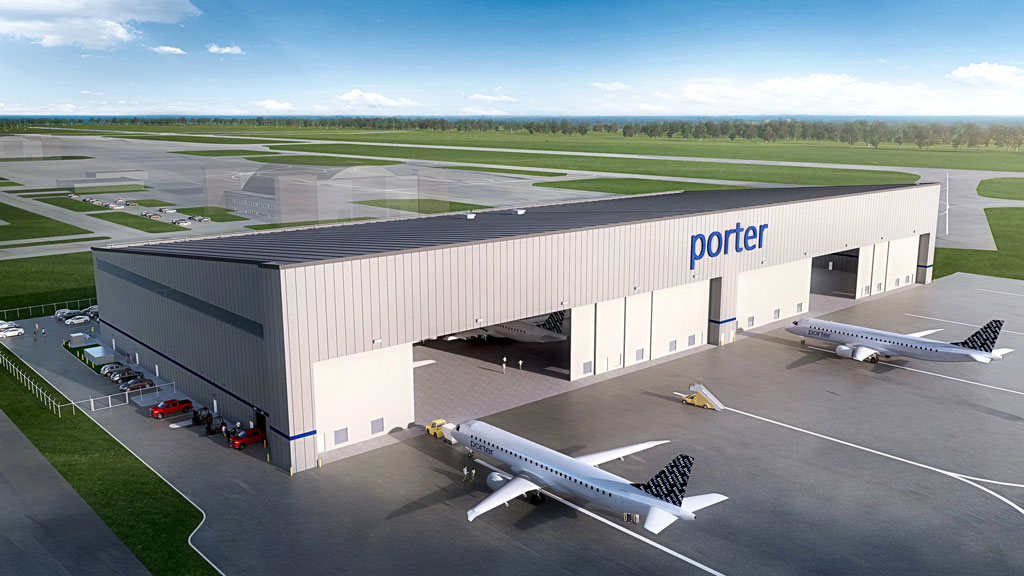Behind a stretch of concrete barriers and wire fencing at Ottawa International Airport, a dozer is pushing dirt while operators in a couple of excavators use the buckets to claw at a mound of brown soil.
A short distance away, paving crews are laying down asphalt for a new taxiway. A cloud of grey-white smoke rises from the newly laid pavement as the workers and equipment slowly move forward.
Welcome to the latest in a long series of projects at the airport which are aimed at revitalizing the facility and preparing it to accommodate the growing demands of the National Capital Region.
Two massive aircraft hangers with more than 150,000 square feet of space are being built by Porter Aviation Holdings Inc. The $65-million project is creating more than 150 construction jobs.
The hangars are being built in phases. Phase one is scheduled for completion by the end of 2023, and phase two in the first quarter of 2024.
“Ottawa has been a critical location for Porter throughout our history and the multimillion-dollar facilities we’re building to maintain aircraft here is only the latest example of our desire to meaningfully invest in Canada’s Capital Region,” says Michael Deluce, president and CEO of Porter Airlines. “We anticipate our presence in Ottawa will grow in the coming years, supported by the maintenance base and future aircraft deliveries that give us the ability to consider new routes.”
The airport will be the primary maintenance base for the E195-E2, with Porter hiring 200 local team members, including 160 aircraft maintenance engineers. Other positions include shop technicians, stores clerks and administrative support.
The hangars are being built with indoor parking for up to eight aircraft, a shop for repairs and modifications of metal and composite aircraft parts, along with repair, wheel and battery shops.
The buildings have been designed with sustainability in mind. Design criteria of the hangars will exceed current energy efficiency standards, including for heating, ventilation, air-conditioning, lighting and electrical power systems.
The hangars themselves will be clad in insulated metal panels that are considered to be superior to the standard metal siding usually found on aircraft hangars. Anticipated lifespan is 60 years.
Additionally, the hangars are being constructed from materials that have a low embodied carbon footprint of up to 28-per-cent less than conventional tilt-up assemblies and approximately 35-per-cent recycled steel which, at end of life, can be recycled.
Meanwhile, a predominantly electric fleet of vehicles will be used for towing and servicing aircraft, as well as ground support.
The hangars will span approximately 86 metres. A substantial clear span has been achieved by using prefabricated trusses. The steel tonnage-to-span ratio is about 30 per cent less than conventional rolled steel section beams.
To protect the hangars from fire damage, a dual system is being used. In addition to a conventional sprinkler system, the aircraft parking and maintenance areas will be equipped with an instantaneous foam deluge system. In the event of a fire, the multi-layers of fire suppression do not rely on a conventional single source of water supply. The city hydrant system is fully supplemented by an onsite underground water storage tank containing approximately 1.2 million litres of water.
The hangars have been designed to exceed current energy efficiency standards. Stormwater management has also been factored into the design. Instead of rain and stormwater flowing directly into and over-stressing city mains, two 173,000-litre underground tanks are being installed to capture excess runoff.
Ottawa International Airport Authority president and CEO Mark Laroche says the organization is particularly pleased that sustainability factors so prominently in Porter’s plans, because it fits perfectly with the airport’s ambitious commitment to net-zero operations by 2040 or sooner.
The hangars are designed by Scott Associates Architects. PCL is acting as construction manager together with Span Construction & Engineering.
A new, $15-million taxiway at the airport was recently completed in the north field area of the airport to accommodate the hangars, as well as federal government needs, and possibly other commercial aviation-related development. It represents the first air-side expansion project since 1977.
Laroche says the association knew the taxiway project would unlock development potential and he is pleased at the speed at which the private sector seized the opportunity.
The airport has also set aside 25,000 square metres of land to meet the near-immediate needs of the federal government and there are hectares more available for development.
Porter now has up to 100 E195-E2s on order, including 50 firm commitments and 50 purchase rights. The company’s current Dash 8-400 fleet includes 29 aircraft.
Back in 2006, when Porter Airlines launched, the company chose Ottawa as the inaugural destination.
In 2017, Porter was lead sponsor of Ottawa’s 150-year anniversary celebrations, and in 2022, it seems fitting that Porter has chosen Ottawa to play a pivotal role in maintaining the expanded fleet, he says.
“This project is just the beginning.”



Recent Comments